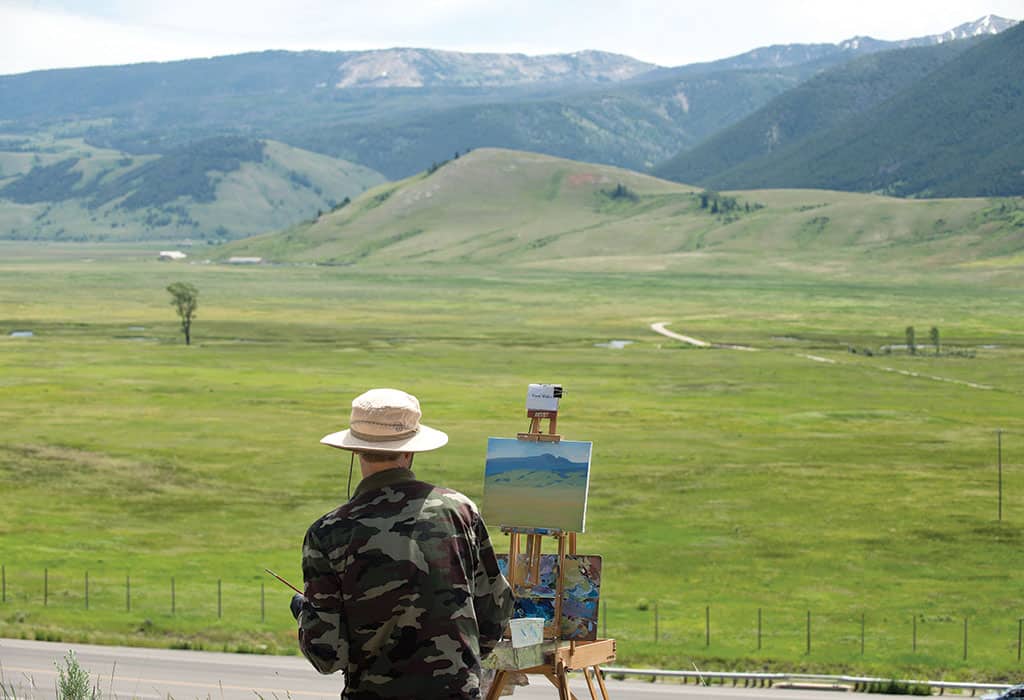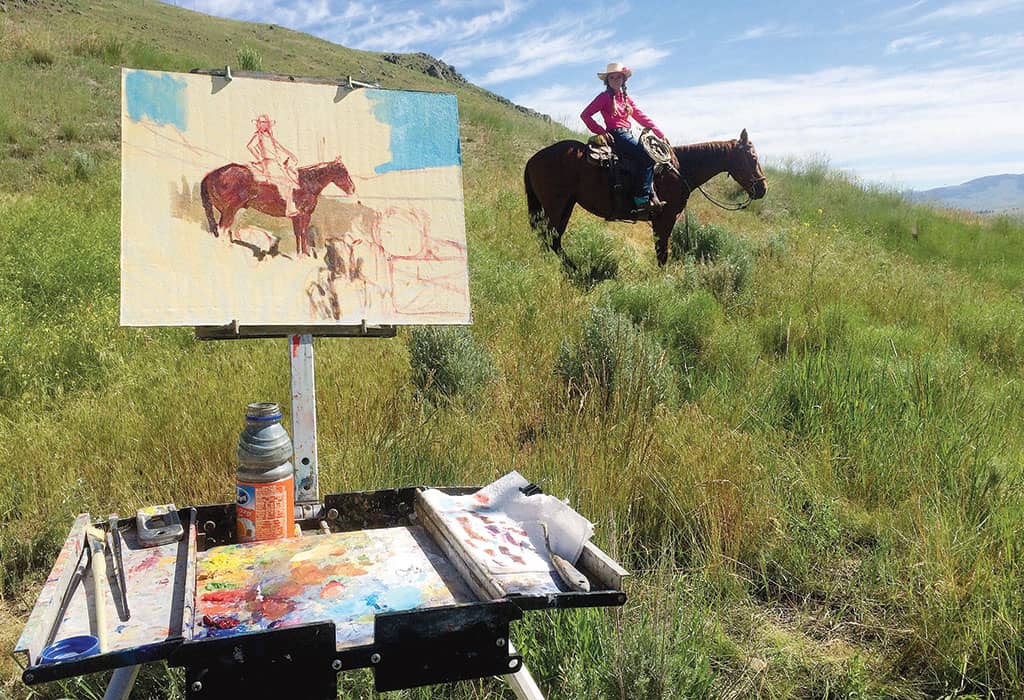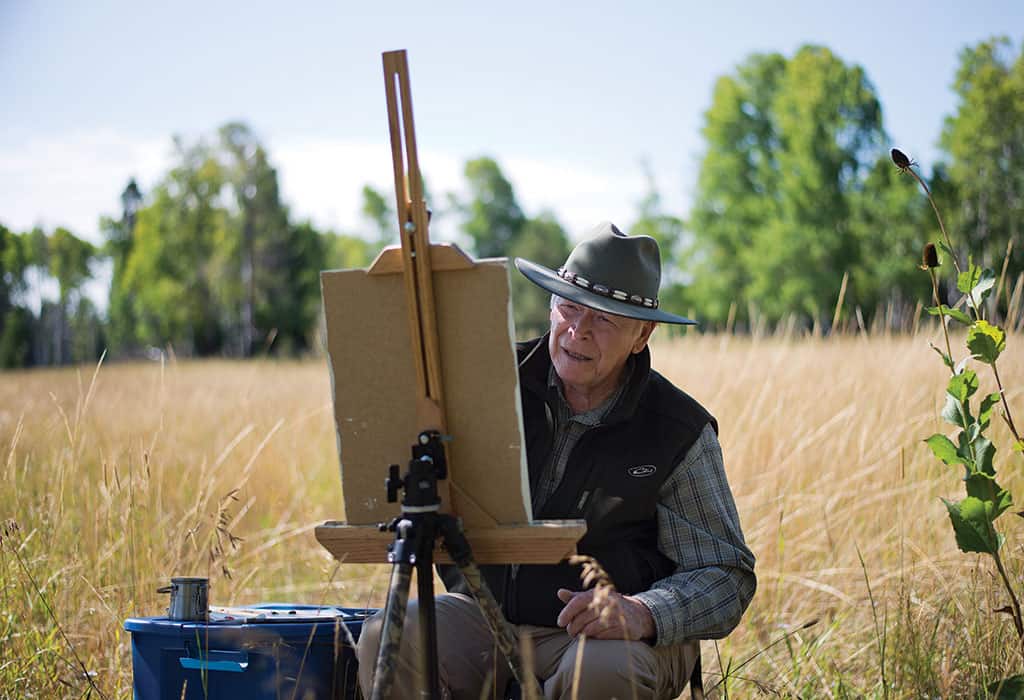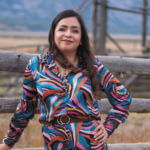Read The
Current Issue
Plein as Day
When Mother Nature is your model, plein air is your passion.
By Jeannette Boner

IT’S A WARM spring day, and the Gros Ventre Mountains are in full bloom, sporting every shade of green. Overhead white pillows of clouds cast contrasting shadows along the eastern edge of Jackson Hole. At a spot not far from downtown and overlooking Flat Creek, the National Elk Refuge, and the Gros Ventres, a small army of art professionals and appreciators gathers at the National Museum of Wildlife Art’s annual Plein Air Fest. Armed with paints and palettes, artists render Mother Nature’s display of color and light onto their canvases as they only can when painting outdoors. The artists work to reproduce the landscape, including delicate details like blooming forget-me-nots, sticky geranium, and Indian paintbrush. They wrestle the landscape’s enormity into the confines of their canvases.
“Every time I go up there, and it’s a couple of times a summer, I try to capture what I see,” says Charles Dayton, a Wyoming native and plein air painter whose work is featured at Jackson’s Wilcox Gallery. “The Tetons are so, so … the enormity of the Tetons, they are endless. And the contrast with the sagebrush valley that drops into the willows and cottonwood. You see things that you wouldn’t see if you just traveled by a location. When you are in it, you see colors and details that you can’t experience without intense observations. It’s all really wonderful.”
Dayton brought his daughter to Plein Air Fest. She’s on horseback in the middle of a sagebrush field modeling for him. The Gros Ventres drape around her shoulders, and the blue sky frames her perfectly pressed pink, pearly button-down. Dayton’s attitude is easy as he jokes with her, him at his easel, she in the saddle. (This is her first modeling gig for her dad.) A painter standing next to Dayton laughs along, too. Each man wears a cowboy hat and boots and Wranglers. Instead of six-shooters at their hips, they’re armed with flat brushes and big brushes, and tubes of oil and acrylic paints, disarming visitors with their display of western art.
The museum’s sidewalk is lined with artists, some ready to chat and hand out business cards, others deep into their scene. Travis Walker, one of the most notable local artists and the founder of the nonprofit Teton Artlab, is here. He’s barefoot and working his brush quickly, smashing sky and mountains together over Flat Creek with the various greens of the Gros Ventre Range in the background. “When I am working outside, I am reacting directly to the landscape. I try not to think too much and just use my instincts,” Walker says. “Sometimes these attempts fail to create a good painting, and that is OK. Actually it is essential to fail, because I learn what doesn’t work, which is important to recognize. Back in the studio I take the work I made in the field and experiment with scale and color more. In this respect I feel like a scientist who collects data in the field that can be further analyzed in the studio.”

“PLEIN AIR” IS a French term that means to paint outdoors. But landscape as a subject can be fickle and unforgiving—light splashing down and around sharp edges, soft spaces, and trees, and casting shadows and moving faster than a summer season in the Rockies. But artists enjoy the challenge, and keep coming to the Tetons with a willingness to allow Mother Nature the time she needs to show her full glory under the banner of endless western skies.
In addition to the NMWA’s Plein Air Fest, every July there is Plein Air for the Park, which takes place in Grand Teton National Park. Both of these events have filled up fast in recent years, attracting local and visiting artists. Seeing the popularity of plein air painting, Teton Valley also has its annual Driggs Digs Plein Air festival. For several years now, upwards of seventy-five artists have taken part in it. Although popular, plein air painting comes with challenges that studio painting does not.
“SOME OF MY biggest challenges are the changing conditions,” says David Koch, a Utah-based plein air painter who has traveled to the Tetons to paint for decades. “It’s important that you know, even before you put a brushstroke on canvas, what you are going to paint and why you chose that scene.” Another challenge, adds Koch, is “chasing the light.” For many artists the goal is not the finished product or its sale. They strive for their plein air pieces to communicate to the world—to tell viewers what they saw in the long shadows of the early morning, or the color and contrast of an evening scene, says Koch, who enjoys plein air painting in deserts as well, particularly the light of Utah’s famed canyonlands.
Plein air painting is not as easy as snapping a photo and taking it back to the studio to complete, Koch says. Plein air works contain subtle layers of time and space. Artists capture hours of light and color. The end result is often emotional rather than purely representational. Still, “What first comes to mind as a plein air painter is accurately recording nature,” Koch says.“[Plein air] teaches us to really see things as they are and that benefits society by making people aware of how beautiful things really are. It records things that will change.”
Some plein air painters sketch and put a basic idea onto canvas in the field and then take the piece into the studio to finish. Other plein air artists complete their entire work outside. Koch sometimes takes pictures if he knows he’ll finish a piece in his studio. Dayton favors preserving a scene by memory.
ON THE WESTERN side of the Tetons, in Teton Valley, Scott Christensen’s gallery/studio is awash with light streaming through Darby Canyon. The world-renowned artist stands at the front of a group of fifteen students. He’s teaching them how he re-creates the outdoors with paint. He begins with a few scratching noises on a massive mountain landscape. He’s cooling off the sky while warming the peaks. Reflective light gets a bump with a few more strokes of his brush. Christensen doesn’t speak or address his audience, which includes a fifteen-year-old prodigy. Instead he turns to a massive mirror opposite his painting of the Grand Teton; he uses the mirror to assess the slight variations of light and temperature that go unseen by untrained eyes. “Wow,” a few students whisper as Christensen reveals his delicate changes.
“The more you experiment, the more you learn,” he says as he continues to cool and warm various elements in the piece. Christensen uses several brushstrokes to make the sky reflect off of a high mountain lake. “You have to be willing to lose your work to gain academically,” he says.

THE ORIGINAL PLEIN air professor is the Tetons. Famous artists armed with experience and students eager to capture dramatic western landscapes came here. Today plein air painters continue to come. No matter the season, even winter, they persevere, wrestling oil and acrylic and chalk and watercolor onto canvas. The task can feel daunting, given the area’s awe-inspiring beauty and delicate details, like sagebrush, wildflowers, and cottonwoods.
“I am constantly tweaking,” says Christensen. “These are the decisions I make—to give life or not. I’m breathing life into a painting made from real life. You are going to ruin paintings. That’s OK. I’m different today than I will be tomorrow. I have a lot of people say, ‘I don’t want to think that much.’ It’s OK. Everyone’s different, and you’re doing these [paintings] for a purpose.”
Perhaps no one wrestled more with the challenge of painting outdoors than famed plein air pioneer Conrad Schwiering. For him, painting outside was about being in the scene as much as it was about capturing it with paint. “I plan on going out every day to sketch these mountains no matter what sort of weather is brewing,” he once said. “Because this is really what a mountain painter does—he catches, if he can, the essence of the moods, as they come across the mountains, hoping he can pass them on to others.”
Schwiering, who died in 1986, plowed through paint to find the shifting light in the deep canyons of the Tetons in pursuit of emotion. From his Jackson studio he inspired generations of artists, challenging them to move beyond the confines of four walls to the limitless possibilities of the field. When asked how long it takes to complete a picture, Schwiering replied, “Oh, I’d say about two weeks and thirty-five years.”




